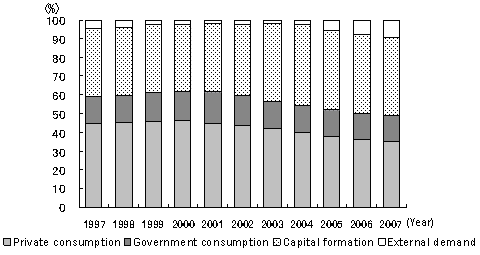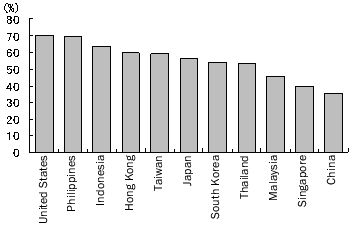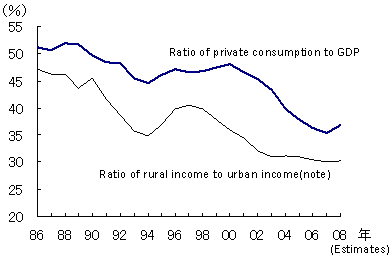In recent years, the Chinese economy has posted impressive annual growth rates in excess of 10%. The structure of China's gross domestic product (GDP) by demand component shows the country's economic growth is due primarily to investments and external demand. Domestic consumption in China has, in fact, remained weak. This situation is reflected in private consumption, which has been falling year after year relative to GDP. China's ratio of private consumption to GDP declined to 35.3% in 2007, an extremely low level compared to 70.3% for the United States and 56.3% for Japan ( figures 1 and figures 2 ).
The ultimate goal of economic activities is to improve, via consumption, standards of living. Encouraging consumption is an important issue for the Hu Jintao administration, which advocates "people-oriented" policies. Promoting consumption has been attracting particularly strong attention as part of China's countercyclical measures proposed in response to the rapid deceleration of the country's economy since fall 2008.
Figure 1: Structure of major demand components of China's GDP (nominal GDP)

(Source) hina Statistical Abstract 2008
Figure 2: International comparison of private consumption in relation to GDP (2007 figures)

(Source) Official statistics for China, Japan, and the U.S.; Asian Development Bank (ADB) Key Indicators 2008 for other countries and regions
Redistribution of income and wealth as the key
The widening disparity of income among citizens, income and wealth concentrated in the hands of the central government instead of its citizens, and underdeveloped social security systems can be cited as factors behind China's consumption slump. The Chinese government must correct these conditions if it is to encourage greater domestic consumption.
To begin with, income is becoming increasingly polarized in China, as can be seen in the gap between urban areas and rural areas, and between coastal regions and inland territories. Income disparity is widening because the propensity to consume (the ratio of consumption expenditure to income) falls as income rises, indicating that an increasing amount of income is becoming concentrated in the upper income bracket. This trend curbs the consumption of the entire nation. In fact, the ratio of private consumption to GDP in China has been falling in step with the widening gap between urban areas and rural areas ( figure 3 ). Tax reforms aimed at income redistribution, which includes the introduction of an inheritance tax and a strengthened local tax allocation system, are essential for reducing the income gaps.
Figure 3:Stagnant private consumption due to widening income disparity

(Note) Per capita disposable income and per capita net income are used for urban areas and rural areas, respectively
(Source) China Statistical Abstract 2008
Moreover, income and wealth are concentrated in the central government rather than in households, which is another situation restricting consumption in China.
Up to this point, China's state-owned enterprises have paid almost no dividends to the state (central government), which is their shareholder, in spite of substantial improvements in their profits in recent years. In 2008, large state-owned enterprises under central government control were required to pay to the government either 5% or 10% of their profits, depending on their type of industry. However, little has changed in a situation wherein a significant percentage of these enterprises' remaining profits is retained internally and circulated within the corporate sector. If the profits of state-owned enterprises were included in the state budget as a source of revenue, their benefits could be returned to Chinese citizens in the form of tax cuts and other measures. These measures would then increase disposable household income and, by extension, consumption in China.
The most effective way to raise the purchasing power of farmers is to acknowledge and guarantee their rights to their land. Until now, under the country's "collective ownership system" only land-usage rights have been acknowledged for farmers in China, who have no ownership rights to their land. Farmers who migrate to urban areas are forced to abandon their rights to use agricultural land. If land were to become the private property of farmers, its "wealth effect" would boost consumption in rural areas. Awarding farmers greater rights to their land was announced as a national policy at the Third Plenary Session of the 17th Central Committee of the Communist Party of China (CPC; or "Third Plenum of the 17th Central Committee") held in October 2008. Granting farmers the right to sell their land, improving compensation for land expropriation, and extending the land lease limit beyond the present period of 30 years were some of the reforms cited under the policy. Implementation of the policy is expected to generate greater consumption.
Finally, because social security systems remain inadequate, Chinese citizens must curb their consumption and save a relatively large percentage of their income to safeguard against unexpected events such as unemployment, illness, and retirement. In many advanced countries, citizens can allocate a relatively greater percentage of their income to consumption because a full range of social security benefits such as unemployment insurance, medical insurance, and old-age pension plans are available to them.
In the era of the planned economy, communes and state-owned enterprises had provided these social services in China's rural areas and urban areas. However, communes were dissolved and state-owned enterprises were increasingly privatized as the transition from planned economy to market economy advanced in China. Enterprises that remained under state control began to focus on economic activities. The previous social security systems essentially collapsed as a result of these changes, but China has yet to establish new social security systems to replace the old ones. This problem is more serious in rural areas than in urban areas. Establishing social security systems that also cover rural regions is a prerequisite for promoting consumption in China.
Drawing attention as part of countercyclical measures
In November 2008, the Chinese government announced four trillion renminbi worth of new spending measures focused on infrastructure investment to boost domestic demand. At the same time, the government began looking for new ways to increase consumption. At a January 6, 2009, roundtable discussion on economic and fiscal policy, Vice Premier Li Keqiang, China's leading economic and fiscal policymaker, emphasized the government's intention to "steadily advance the adjustment of the distribution structure for national income, focus on improving the security and standards of Chinese citizens' lives, further support and relieve low-income households, raise individual capacity for consumption, and place great emphasis on the expansion of personal consumption" as policy matters in the period ahead.
As the centerpiece of its initiative to bolster consumption, the Chinese government expanded the scope of its subsidy system for farmers buying home electronics ("Home Electronics to Rural Areas"( note )) from limited areas to include the entire nation in February 2009. To boost sales of automobiles, the government is also planning to lower the sales tax, for a limited period of time, from 10% to 5% on vehicles smaller than 1,600 cubic centimeters (cc's), and subsidize farmers who buy replacement trucks and minivans smaller than 1,300cc's. In addition to these plans for aiding the purchase of specific products, the government is also considering a general reduction in the individual income tax. Once these moves get up to speed, consumption growth will join greater infrastructure investment as pillars of China's countercyclical measures.


